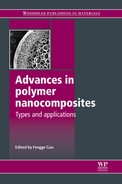Preface
Filler-enhanced polymer nanocomposite technology is one of the driving forces in stimulating and promoting nanotechnology development. At present, nanotechnology has expanded into almost every aspect of science and technology. It may be appropriate to summarise today’s nanotechnology as the science and technology developed within the ‘nanometre range’. This summary appears to be too generous and somewhat confusing but may truly represent what has happened in this field. The original initiative for nanotechnology was to develop new and much better materials within the nano-size range, which had been ignored before. For filler-enhanced materials, innovation has led to greatly improved properties and functions, which cannot be obtained using traditional macro- and micro-technology within normal filler loading levels. For devices, innovation has led to novel functions and applications, which were not previously possible. However, this aim has only been partially achieved over the past one and half decades. There are two reasons why there has been a move away from the initial aim. First, the commonly accepted size range in the original definition for nanotechnology, 1 to 100 nm, is fairly random and during the early stages of development there was a lack of scientific evidence to show any difference between materials in this range and in the micro-range. In fact, it is has become more and more clear that many types of particle larger than 50 nm have similar properties to microparticles. Therefore, most particles between 50 nm and 100 nm, and also larger particles, do not show a dramatic enhancement of material properties as originally expected. The second reason was that some scientists took advantage of the better opportunities for funding and the publications in nanotechnology, to rename well-developed scientific fields with some relevance to the 1–100 nm range as nanotechnology. As a consequence, today’s nanotechnology is a mixture of both innovative new developments and less competitive traditional science and technology. Filler-enhanced nanocomposite technology is one of those truly innovative areas, whose results could not have been achieved before. In the early days of this technology, the Toyota team demonstrated that exfoliating smectite clay to create nanoparticles as polymer fillers, could lead to a dramatic enhancement of a wide range of physical and engineering properties using a very small fraction of filler loading compared with traditional micro-dispersed clay/polymer composites. Since then clay/polymer nanocomposite technology has been used with almost every type of polymer. More and more nanofillers have been identified and used for different polymeric products. Whilst other areas of nanotechnology were still in the concept stage, filler-enhanced polymer nanocomposite technology was used in various commercial products from the very beginning. These developments were a catalyst in promoting innovative nanotechnology in other polymer fields.
This book was originally designed to be a handbook covering fundamental knowledge, major scientific progress and applications of filler-enhanced polymer nanocomposites for each filler and polymer. However, the rapid progress and expansion of this field and the busy lives of the experts forced us to change the format of the book. We have started with selected nanocomposite research fields, which have the potential to form a series of chapters to cover the progress made in this subject on a regular basis systematically. This first book follows the original design and covers research on polymer systems, types of filler and applications. Part II of this book is on polymer systems and includes relatively mature developments in nylon and difficult polymer systems such as polyolefins, PVC and PET. It will also highlight new developments in soft nanocomposites and gels, thermoplastic polyurethanes and biodegradable polymer nanocomposites, which generate much public interest. In Part I, on the types of filler, there are no chapters on fillers such as clay since these are discussed extensively in most of the chapters in Part II on polymer systems and in Part III on applications. Part I covers those filler systems that have not been extensively discussed elsewhere, such as cellulose, metal and calcium carbonate nanofillers, together with the relatively popular fillers, carbon nanotubes and layered double hydroxides. We felt that it was important to address the health and safety aspects of nanoparticles and their composites and the life cycle performance of this new class of material. Unfortunately we could not include a chapter on the toxicity of nanocomposites in this current volume, but there is a chapter on life cycle assessment in Part I. Although nanocomposite technology has only been under development for a relatively short time, its applications have spread to many fields. Part III of this volume includes only a few selected applications in fuel cells, aerospace products, optical products, fire retardancy and coatings. More applications will be included in subsequent volumes in this series.
Finally I would like to thank all the authors who squeezed valuable time out of their busy lives to contribute to this book and those reviewers who gave invaluable critical comments on the manuscripts. The editors and staff at Woodhead Publishing Limited played a major role in editing this book. Many thanks for your hard work.
